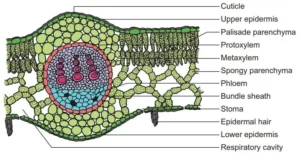Identify and label the cuticle, cellular and tissue structures of a dicotyledonous leaf, as seen in diagrams or photomicrographs, and explain how these structures are adaptations for photosynthesis and gas exchange, limited to: (a) stomata and guard cells (b) spongy and palisade mesophyll cells (c) air spaces (d) vascular bundles (xylem and phloem) (e) distribution of chloroplasts (f) upper and lower epidermis
Identify and label the cuticle, cellular and tissue structures of a dicotyledonous leaf, as seen in diagrams or photomicrographs, and explain how these structures are adaptations for photosynthesis and gas exchange, limited to: (a) stomata and guard cells (b) spongy and palisade mesophyll cells (c) air spaces (d) vascular bundles (xylem and phloem) (e) distribution of chloroplasts (f) upper and lower epidermis
Please login to submit an answer.
In a dicotyledonous leaf, various structures are adapted to optimize photosynthesis and gas exchange. Below is an identification and explanation of key features, including the cuticle, cellular and tissue structures such as stomata, guard cells, mesophyll cells, air spaces, vascular bundles, chloroplast distribution, and epidermis.
1. Cuticle
- Description: The cuticle is a thin, waxy layer covering the outer surface of the leaf.
- Function: It minimizes water loss through evaporation while allowing light to penetrate for photosynthesis. This adaptation is particularly important in preventing excessive transpiration in arid environments.
2. Stomata and Guard Cells
- Description: Stomata are small openings located primarily on the lower epidermis of the leaf. Each stoma is surrounded by two specialized cells called guard cells.
- Function: Stomata facilitate gas exchange by allowing carbon dioxide (CO₂) to enter the leaf for photosynthesis and oxygen (O₂) to exit as a byproduct. Guard cells regulate the opening and closing of stomata in response to environmental conditions (e.g., light intensity and humidity), balancing gas exchange with water conservation.
3. Spongy and Palisade Mesophyll Cells
- Palisade Mesophyll:
- Description: Located just beneath the upper epidermis, palisade mesophyll cells are elongated and tightly packed with chloroplasts.
- Function: Their arrangement maximizes light absorption, as they capture sunlight efficiently for photosynthesis.
- Spongy Mesophyll:
- Description: Found below the palisade layer, spongy mesophyll cells are irregularly shaped and loosely arranged with large air spaces between them.
- Function: These air spaces facilitate gas diffusion (CO₂ and O₂) throughout the leaf, enhancing gas exchange efficiency.
4. Air Spaces
- Description: The intercellular spaces between spongy mesophyll cells form a network of air pockets.
- Function: These spaces allow for the easy movement of gases within the leaf, ensuring that CO₂ can diffuse into cells for photosynthesis while O₂ can diffuse out.
5. Vascular Bundles (Xylem and Phloem)
- Description: Vascular bundles consist of xylem and phloem tissues arranged together within the leaf.
- Function:
- Xylem: Transports water and minerals from the roots to the leaves, which are essential for photosynthesis.
- Phloem: Distributes the sugars produced during photosynthesis from the leaves to other parts of the plant for growth and energy storage.
6. Distribution of Chloroplasts
- Description: Chloroplasts are organelles containing chlorophyll, primarily located in mesophyll cells.
- Function: The high concentration of chloroplasts in both palisade and spongy mesophyll cells allows for maximum light absorption and efficient conversion of light energy into chemical energy during photosynthesis.
7. Upper and Lower Epidermis
- Upper Epidermis:
- Description: The upper epidermis is a single layer of protective cells that often lacks stomata.
- Function: It provides protection against physical damage and pathogens while allowing light to pass through to the underlying mesophyll.
- Lower Epidermis:
- Description: The lower epidermis contains more stomata than the upper epidermis.
- Function: This arrangement facilitates greater gas exchange while minimizing water loss through transpiration.

- Share on Facebook
- Share on Twitter
- Share on LinkedIn
Helpful: 0%




